|
|
|
Sort Order |
|
|
|
Items / Page
|
|
|
|
|
|
|
| Srl | Item |
| 1 |
ID:
185874
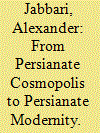

|
|
|
|
|
| Summary/Abstract |
This article examines twentieth-century Persian translations of Urdu-language works about Persian literature, focusing on two different Persian translations of an influential Urdu-language work on Persian literary history, Shiʿr al-ʿAjam (Poetry of the Persians), by Shibli Nuʿmani. The article offers a close, comparative reading of the Afghan and Iranian translations of Shiʿr al-ʿAjam in order to understand why two Persian translations of this voluminous text were published within such a short time period. These translations reveal how Indians, Afghans, and Iranians were invested in the same Persianate heritage, yet the emergence of a “Persianate modernity” undergirded by a cultural logic of nationalism rather than cosmopolitanism, along with Iran’s and Afghanistan’s differing relationships to India and Urdu, produced distinct approaches to translation.
|
|
|
|
|
|
|
|
|
|
|
|
|
|
|
|
| 2 |
ID:
184813
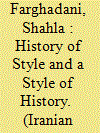

|
|
|
|
|
| Summary/Abstract |
This article considers style in Persian literary history and its critical rhetorical and hermeneutical roles for poets and critics in the medieval and Safavid-Mughal eras. It explores how tarz (manner) emerged as a hermeneutical term in the thirteenth and fourteenth centuries and achieved a central position in sukhansanjī (evaluating speech) in the seventeenth and eighteenth centuries. This account of tarz—grounded in its historicity and multivalent implications—offers new insights into language for early modern Persian literary history, which is often periodized as sabk-i hindī (Indian style) or tāza-gūyī (fresh-speaking). Through a close reading of Safavid-Mughal tazkiras (literary compendiums), this contribution examines tarz as an operating concept deployed by a number of prominent tazkira writers. Finally, the article concludes by discussing this legacy's impact on twentieth-century scholarship.
|
|
|
|
|
|
|
|
|
|
|
|
|
|
|
|
| 3 |
ID:
192994
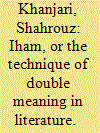

|
|
|
|
|
| Summary/Abstract |
This article examines the chapter on īhām (literary amphiboly) in Ḥadāʾiq al-Siḥr by Rashīd Vaṭvāṭ (d. 1182). Ḥadāʾiq, a treatise on stylistics with Persian and Arabic examples, is the oldest extant document to define īhām. Vaṭvāṭ's definition of īhām sheds light on the mechanism and function of this literary technique. This article argues that īhām, according to Vaṭvāṭ, operates through the creation of semantic fields and defamiliarization. Previous scholars who examined this chapter of Ḥadāʾiq, oblivious to this point, have made a number of misinterpretations. However, by analyzing the name he prefers for this figure of speech, the definition he gives, and the examples he cites to explain it, this article demonstrates that Vaṭvāṭ had this function of defamiliarization in mind.
|
|
|
|
|
|
|
|
|
|
|
|
|
|
|
|
| 4 |
ID:
127784
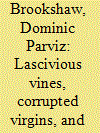

|
|
|
|
|
| Publication |
2014.
|
| Summary/Abstract |
The Persian wine production myth centers on the relationship between a male vintner and his female vine and her daughters, the grapes. This myth, the earliest extant examples of which are found in qas?das by the Samanid poets R?dak? and Bashsh?r Marghaz? and which was much developed by Man?chihr? and his contemporary Farrukh?, contains images of femininity, the mother-child bond, separation, violence, execution, and ultimate redemption. The grape harvest comes in the late summer and culminates in the Mihrag?n festival, a celebration focused on the grape and grape wine, at which poems containing versions of the wine production myth were recited. The present study maps the evolution of this myth over the span of a century through a close reading of eleven poems with specific reference to variations in narrative structure.
|
|
|
|
|
|
|
|
|
|
|
|
|
|
|
|
| 5 |
ID:
143586
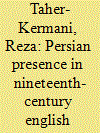

|
|
|
|
|
| Summary/Abstract |
This study employs keyword searches of literary databases such as Literature Online (LION) in an attempt to map the image of “Persia” in nineteenth-century English poetry as it was molded by a proliferation of thoughts and ideas in a variety of contexts. Completeness is not possible, of course, but the article aims to identify and explore some of the major categories within which the image of Persia was formed and disseminated in the nineteenth-century. The scope of the study is not confined to a corpus of poetic works that were written specifically on or about “Persia,” but takes account of a broader range of poems, and attends to the structure, texture and variations of the presence of “Persia” in nineteenth-century English poetry.
|
|
|
|
|
|
|
|
|
|
|
|
|
|
|
|
| 6 |
ID:
129015
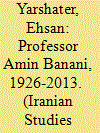

|
|
|
|
|
| Publication |
2014.
|
| Summary/Abstract |
Professor Amin Banani was one of the pillars of Iranian Studies in the United States and his passing leaves a conspicuous and regrettable gap in providing instruction and guidance with respect to Iranian history and Persian literature. He could speak with authority about the entire field of Iranian Studies, even though his expertise did not extend to pre-Islamic Iranian languages and religions.
|
|
|
|
|
|
|
|
|
|
|
|
|
|
|
|
| 7 |
ID:
186552
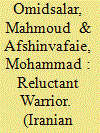

|
|
|
|
|
| Summary/Abstract |
Zāl is the embodiment of the heroic culture which shapes and determines the conduct of the Shāhnāmeh heroes from Manūchihr through Rustam's death. For Zāl to attain that level of moral authority, the poem semiotically endows him with innate wisdom symbolized by his white hair at birth. By the end of the story, when he is still a relatively young man, he has gained the authority to change the ruling dynasty by choosing and crowning kings at will (e.g. his crowning of Zav and Kayqubād). Zāl's story is thus a tale of transformation that seamlessly fits into the overall narrative of the Shāhnāmeh. It helps the poem's narrative make the transition from the age of ancient kings in whom heroism, royal authority, and magical potency are combined, to the era of a different line of rulers who govern by royal authority alone. This process moves in two parallel lines: the transfer of the magical wisdom of the primordial kings to the person of a sage who functions as the embodiment of sagacity and prudence, and the transfer of their heroic aspect to a great warrior who serves as the country's “chief hero,” its jahān pahlawān. With the exception of Kaykhosraw, whose character has very strong supernatural and religious dimensions, every important legendary king after Manūchihr has a sage on whose advice he depends (e.g. Zav, Kayqubād and Kaykāvūs have Zāl, Gushtāsp has Jāmāsp, and Alexander has Aristotle). The king also has a warrior who holds the office of the jahān pahlawān (Kaykāvūs and Kaykhusraw have Rustam, Luhrāsp has Zarēr, and Gushtāsp has Isfandiyār).
|
|
|
|
|
|
|
|
|
|
|
|
|
|
|
|
| 8 |
ID:
127783
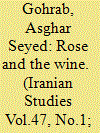

|
|
|
|
|
| Publication |
2014.
|
| Summary/Abstract |
As everyone knows, alcoholic drinks, including wine, are forbidden by Islam. Readers of Persian poetry often wonder how is it possible that Persian wine literature is one of the richest in the world and whether the poets and authors ever address the illicitness of the wine in their works. This article examines how one author, Zang? Bukh?r?, presents a catalogue of positive and negative qualities of wine in his Gul u mul ("The Rose and the Wine"). Through the genre of debate (mun?zara), he shows how a courtly audience may have tried to justify the drinking of wine. The article examines the formal generic characteristics of such debates, showing how the form of the debate is rather appropriate to let forbidden objects or ideas, in this case the wine, speak for themselves thus defending their position in an Islamic society. entertaining in is richness in metaphors and imagery used by the wine and the rose to voice their superiority to each other, but it also addresses a rather controversial topic in an uncontroversial style.
|
|
|
|
|
|
|
|
|
|
|
|
|
|
|
|
| 9 |
ID:
127785
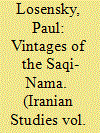

|
|
|
|
|
| Publication |
2014.
|
| Summary/Abstract |
Drawing on a rich tradition of anacreontic poetry and taking inspiration from works by Niz?m? and H?fiz, the s?q?-n?ma or "cupbearer's song" emerged as an independent genre in the early sixteenth century and flourished throughout the Persian literary world for the next 250 years. Looking back on the development of the genre, the early seventeenth-century literary historians 'Abd al-Nab? Qazv?n? and Awhad? Baly?n? give contrasting accounts of its formation, but both agree on the significance of the work of Hak?m Partuv? Sh?r?z? (d. 928/1520-21). An examination of his s?q?-n?ma, together with two other early representatives of the genre by Sidq? Astar?b?d? (d. 952/1545) and Sharaf Jah?n Qazv?n? (d. 968/1561), shows how closely this new genre was tied to the politics and ideology of the new Safavid state and reveals profound structural similarities to the preeminent panegyric genre of the Islamicate world, the qas?da. But once the basic components of the s?q?-n?m? were distilled and taken up by poets outside this socio-political environment, the genre proved to be as protean as the wine symbolism at its core. Cupbearer songs from the end of the century, particularly those of Muhammad S?f? M?zandar?n? (d. 1035/1625-26) and Sanjar K?sh?n? (d. 1021/1612), show how the basic elements of the genre could be reconfigured to serve a variety of more personal interests.
|
|
|
|
|
|
|
|
|
|
|
|
|
|
|
|
|
|
|
|
|